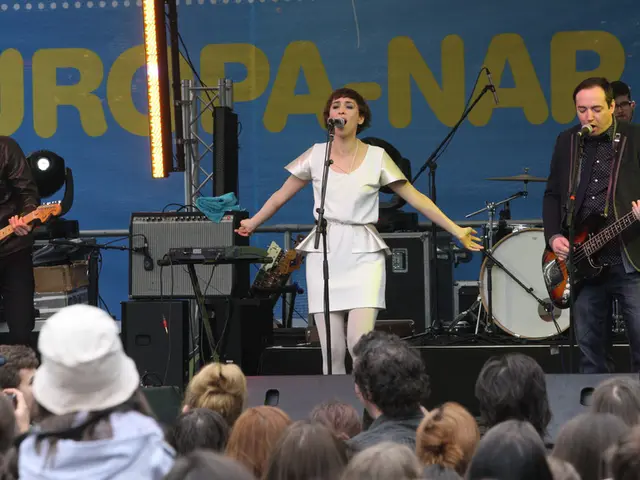Boundaries of the Official Las Vegas Strip Clarified: Demystifying the Myths Surrounding Nevada's Entertainment Hub
The Evolution of the Las Vegas Strip: A Journey Through Time
The Las Vegas Strip, one of the world's most iconic entertainment destinations, has a rich and fascinating history that is deeply intertwined with the development along Las Vegas Boulevard.
The journey begins in the early 1930s, when the Pair O' Dice Club marked the start of the Strip on a barren desert stretch. Fast forward to 1941, and the Strip transformed into a major resort corridor with the opening of El Rancho Vegas, the first full-service casino-resort. Today, the Strip spans about 4.2 miles from the "Welcome to Fabulous Las Vegas" sign at its southern end to Sahara Avenue at the north, primarily within the unincorporated towns of Paradise and Winchester rather than the city of Las Vegas itself [1][3].
The southern boundary of the Strip has been a subject of controversy and ambiguity. While the iconic "Welcome to Fabulous Las Vegas" sign, installed in 1959 by the Western Neon Sign Company, serves as a landmark, its location just south of Mandalay Bay and the Luxor doesn't necessarily define the Strip's southernmost point [2]. This boundary confusion stems from jurisdictional and development factors, as the Strip technically lies outside Las Vegas city limits in Clark County's unincorporated areas [1][3].
The Strip's growth was fueled by resorts like the Flamingo, opened in 1946, which were often backed by organized crime. This led to a proliferation of casinos and mega-resorts, solidifying the Strip's reputation as a high-profile entertainment and gambling destination [1][3]. Over the decades, the boundaries expanded with new resorts appearing further south and north along Las Vegas Boulevard, blurring the distinct borders of the Strip area [1][3].
As of today, there is no universally agreed legal or administrative boundary that precisely defines the Las Vegas Strip. The southern border debate revolves around whether it ends at the "Welcome" sign, more to the south, or further north, a discussion influenced by both marketing and jurisdiction considerations tied to Clark County versus Las Vegas city governance [1].
In recent years, the Strip has continued to evolve, with new developments pushing its boundaries southward. The construction of Allegiant Stadium in 2017 marked the start of this southward migration, transforming the Strip's southern tip into its brand-new sports hub [4]. By 2026, a $3 billion, NBA-ready arena, casino resort, and entertainment district is planned on 25 acres south of the current Strip, further extending the Strip's footprint [5].
The Las Vegas Strip, a nickname for a segment of Las Vegas Boulevard, presents a unique, fluid identity shaped by geography, governance, and commercial development. Its history serves as a testament to the city's resilience and adaptability, making it an ever-evolving symbol of entertainment and excess.
References: [1] Vegas Myths Busted: The Las Vegas Strip's Boundaries. (n.d.). Retrieved from https://www.casino.org/news/vegas-myths-busted-las-vegas-strip-boundaries/ [2] "Welcome to Fabulous Las Vegas" Sign. (n.d.). Retrieved from https://en.wikipedia.org/wiki/Welcome_to_Fabulous_Las_Vegas_Sign [3] Las Vegas Strip. (n.d.). Retrieved from https://en.wikipedia.org/wiki/Las_Vegas_Strip [4] Allegiant Stadium. (n.d.). Retrieved from https://en.wikipedia.org/wiki/Allegiant_Stadium [5] MGM Resorts International. (2021, March 11). MGM Resorts International announces $3 billion, NBA-ready arena, casino resort, and entertainment district on 25 acres south of the current Las Vegas Strip. Retrieved from https://www.prnewswire.com/news-releases/mgm-resorts-international-announces-3-billion-nba-ready-arena-casino-resort-and-entertainment-district-on-25-acres-south-of-the-current-las-vegas-strip-301245492.html
- The Las Vegas Strip, a renowned entertainment destination, spans roughly 4.2 miles on Las Vegas Boulevard.
- In the 1930s, the Pair O' Dice Club marked the beginning of the Strip in a barren desert area.
- The first full-service casino-resort, El Rancho Vegas, opened in 1941, transforming the Strip into a major resort corridor.
- While the "Welcome to Fabulous Las Vegas" sign, located near Mandalay Bay and the Luxor, is a notable landmark, the Strip's southernmost point is a subject of debate.
- The Strip's growth has been fueled by iconic resorts like the Flamingo, which opened in 1946 and contributed to the area's reputation for entertainment and gambling.
- Allegiant Stadium, constructed in 2017, signaled the southward migration of new Strip developments, transforming the area into a sports hub.
- By 2026, there will be an $3 billion, NBA-ready arena, casino resort, and entertainment district south of the current Strip, further extending its footprint.




